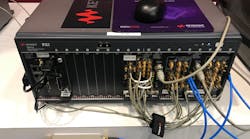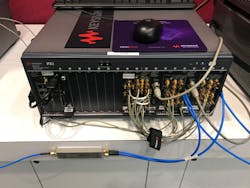Never one to rest on its laurels, Keysight Technologies made a big impression at the recent IMS 2019 thanks to several announcements. One such revelation centered on the launch of the company’s new N5511A phase-noise test system (PNTS), which, according to the company, is designed for phase-noise “power users” at the high end of the market (see figure).
Keysight emphasizes that the N5511A PNTS can measure phase noise down to the thermal phase-noise floor (−177 dBm/Hz), which is the theoretical limit for any measurement at room temperature. What this means is that the N5511A can measure at the limits of physics.
The N5511A phase-noise test system can measure phase noise down to −177 dBm/Hz.
One of the significant features of the N5511A is its dual-channel cross-spectral averaging (cross-correlation) capability. In this configuration, the phase noise of the reference does not limit the effective noise floor of the absolute phase-noise measurement. Furthermore, the internal measurement system noise generated within the phase-detector module is suppressed via the cross-correlation process. By suppressing both reference noise and measurement system noise, cross-correlation results in a sensitivity down to −177 dBm/Hz at room temperature, as mentioned.
In terms of the N5511A’s frequency range, customers have a few options at their disposal. Option 503 equips the system with a carrier frequency range of 50 kHz to 3 GHz, while option 526 allows for a range of 50 kHz to 26.5 GHz. Option 540 is the highest frequency option—it enables a frequency range of 50 kHz to 40 GHz.
However, it’s also possible to perform measurements at carrier frequencies above 40 GHz by employing external components. The N5511A contains the M9550A phase-detector module, which can operate at those carrier frequencies. To make measurements at carrier frequencies above 40 GHz (i.e., beyond 100 GHz), one must use external double-balanced mixers with a 0-Hz IF capability. The external mixer operates as a phase detector and drives the fully calibrated baseband noise input port on the M9550A phase-detector module.
Carrier offset frequencies range from 0.01 Hz to 160 MHz. Such performance is enabled by the M9551A data-converter module inside the N5511A. This module allows for an offset range of 0.01 Hz to 160 MHz thanks to four on-board analog-to-digital converters (ADCs) and a large FPGA for fast FFT processing. Furthermore, the offset frequency range can extend to 3 GHz by using an external signal analyzer.


